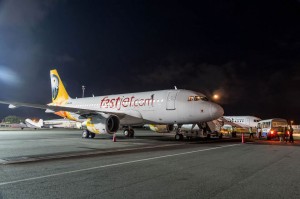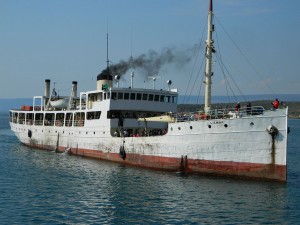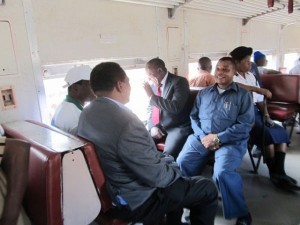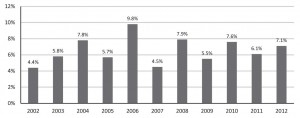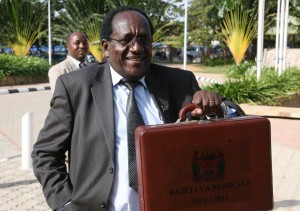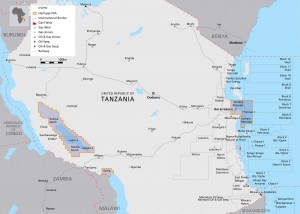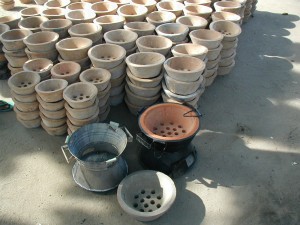By Paul Gooday & James Pringle
Strong economic growth predicted
Tanzania’s economy is expected to see higher growth than other countries in East Africa. This is according to two new surveys by the World Bank and investment firm PineBridge, which highlighted the services and construction sectors and increasing global demand for gold as the key drivers of growth. PineBridge predicted the Tanzanian economy will grow by 7% in 2013, compared to 4.5-6.5% for other countries in the East African Community. (East African)
According to the Standard Chartered Bank Economic Outlook for Tanzania, developments in the energy sector will continue to bolster economic growth both in 2013 and over the medium term, driven by the discoveries of natural gas reserves off the coast of Tanzania estimated at 28.9 trillion cubic feet. The continued growth in agriculture, a successful cotton crop and investment in infrastructure should further brighten the economic outlook, combined with the expected increase in receipts from tourism, gold and manufactured goods.
Tanzania is included in Standard Chartered Bank’s ‘7% club’ – a list of countries with GDP growth strong enough to make the economy double in a decade. (www.tanzaniainvest.com)
Inflation
The rate of inflation for January 2013 has decreased to 10.9% from 21.1% recorded in December 2012. The decrease is explained by the speed of price increases in commodities decreasing compared to December 2012. The inflation rate for food and non-alcoholic beverages decreased to 11.9% in January 2013 from 13.1 % recorded in December 2012. (www.nbs.gov.tz)
IMF Verdict
An International Monetary Fund (IMF) mission, led by Mr. Paolo Mauro visited Dar es Salaam from 21 February to 6 March and issued this statement: “Tanzania’s economy has continued to perform robustly. Economic growth is projected at about 7% in 2013. Inflation has continued to fall, albeit more slowly than envisaged, and is projected to be in the single digits by mid-2013.
Economic policy will aim at further moderating inflation, preserving a sustainable debt outlook, and increasing foreign reserves, which will be facilitated by further enhancing exchange rate flexibility.
The mission was encouraged by the authorities’ readiness to moderately tighten monetary policy to meet their inflation objective of 7% by end-2013. It supported the authorities’ aim for a further reduction in the budget deficit in 2013/14, based on revenue targets, and also transparent support to the power sector. (IMF press release, www.imf.org)
IMF Loan imminent
Tanzania has indicated that it will borrow $114m from the International Monetary Fund, under the standby credit line agreed in 2012. This credit is intended to provide a financial cushion against a reduction in external demand and access to global finance.
The high cost of imports of machinery for oil and gas exploration, and the Eurozone crisis, have had a negative impact on Tanzania’s balance of payments. The IMF loan will act as a buffer against this problem, and will strengthen Tanzania’s position as it prepares to borrow upwards of $600m from the international debt market. (The East African)
Chinese President visits Tanzania, announces $10bn port in Bagamoyo
The recently appointed Chinese President, Xi Jinping, visited Tanzania in late March. He signed a range of economic partnership agreements and announced a $10bn project in Bagamoyo to construct a new port, complete with transport links and an industrial zone. Other agreements covered improvements to Tanzanian hospitals and the building of a Chinese cultural centre.
This was only the second country President Xi has visited since becoming President, after Russia, and was the first stop of a three-country tour of Africa. In a speech given to launch the Julius Nyerere Conference Centre in Dar es Salaam, built with Chinese support, President Xi spoke of the long history of China’s good relations with Tanzania. Details of the Bagamoyo port project have not been released, but according to the Economist Intelligence Unit the scale of the investment suggests a port 20 times the size of Dar es Salaam port. The terms of the Chinese finance for the port, and its operations, are not yet known, but it is expected to become operational by 2017.
A report in the Telegraph noted that China is the second-largest foreign investor in Tanzania, with stakes in agriculture, coal, iron ore and infrastructure, and quoted China expert Jonathan Holslag, head of research at the Brussels Insitute of Contemporary China Studies, as saying that Mr Xi was keen “to showcase that China’s approach to Africa is different from the West,” and that “…China is reviving [their] partnership with Tanzania by investing heavily in its infrastructure”, such as railways that could provide a vital link to Chinese-run mines in the Democratic Republic of Congo.
Later in President Xi’s tour, he joined other leaders of the BRICS grouping (Brazil, Russia, India, China and South Africa), to announce the formation of a new Development Bank. This move was widely seen as a challenge to western-dominated financial institutions, in particular the World Bank. (CNN, Economist Intelligence Unit, Daily News, Guardian.)
Gas
Protests broke out recently in Mtwara region over the extraction of gas and the construction of a pipeline to transport the commodity to Dar es Salaam for refining and eventual sale. The protests caused damage estimated at $929,000 in vandalised property. Four people are said to have died in the riots and scores injured.
Local residents want the gas processing plant constructed in Mtwara instead of Dar es Salaam. Uwesy Salum Hamisis, chairman of the Mtwara elders, said the residents want the government to honour an earlier pledge to set up manufacturing industries, including fertiliser, cement, glass and ceramic plants. Former president Benjamin Mkapa who hails from Mtwara has also raised concerns about the project. However government officials said the gas plant will remain in Dar es Salaam. (East African)
Mining
Peak Resources, an Australian firm, is expected to earn $361m annually from the Ngualla rare earth project in Mbeya region. According to Shaw Stockbroking Ltd, Ngualla is among the top three rare earth projects outside China, and has a pre-tax net profit value of $1.57bn. The site has mineral resources of 170 million tonnes. (The East African)
Banking
Barclays and Absa Group have announced they plan to combine their Africa operations. This deal, worth £1.3bn, would create the largest retail bank on the continent. It follows Barclays’ 2005 purchase of a majority stake in Absa, and efforts since 2011 to integrate the two banks’ operations. Absa would acquire Barclays operations in nine countries, including Tanzania.
Absa currently owns a 55% stake in the National Bank of Commerce (NBC), one of Tanzania’s leading retail banks. The Absa Chief Executive, Maria Ramos, said that no job losses or management changes would result from this move. (Financial Times, with thanks to John Sankey for this item)
The Tanzanian Minister for Finance and Economic Affairs, William Mgimwa, has called on local banks to stop raising lending rates, to encourage economic growth. The government now expects banks to peg their rates to the Bank of Tanzania rate, rather than to Treasury bills yield rates. (East African)
Agriculture
Tanzania’s Parliament on 4 February 2013 adopted a new government programme to provide loans to young people under 35 who are interested in starting agricultural businesses. TShs 200 Billion ($24 Million) will be earmarked annually from the national budget for the project. The Youth Fund will be an important means to curb the problem of youth unemployment. It will empower the young population to create their own employment opportunities, stimulate food production and help the country meet agricultural demands.
The new project is part of the government’s plan to invest a growing share of its budget in agriculture. According to the Director of Youth Development in the Ministry of Information, Culture and Sport, Mr Elisante Ole Gabriel, the government will provide more details on how and where to apply for access to the Youth Fund, which will be available from 1 July 2013. (www.TanzaniaInvest.com)
Tanzania expects to earn $200m in revenues for coffee exports in the 20122013 season, compared to original projections of $250m. This reduction is a result of bumper harvests in South America and reduced demand in Europe and the US. Global prices have dropped by 24% in the past year, and are expected to fall further. The Tanzania Coffee Board plans to expand coffee acreage to an annual production target by 2020 of 100,000 tonnes, compared to 65-75,000 tonnes at present.
The outlook for tea is more positive. Industry managers across the region are expecting high prices following low production worldwide. This is despite a prolonged drought that affected East African tea estates early in 2012. (East African)
Construction and Housing
The National Housing Corporation (NHC) has officially announced a project to build two new satellite towns in Meru and Arusha-Rural Districts, where it owns more than 1000 acres of land. In 2011, 430 hectares were acquired at the cost of TShs 8.6 Billion ($5.4 Million) by the newly established Arusha District Council Trust Company. Hundreds of residential houses and shopping malls will provide low-income earners with ultra-modern residential houses. The houses will be for rent or sale. The project will also boost the District Council’s revenues.
NHC is state-owned and is Tanzania’s oldest public real-estate developer. It operates under the Minister for Lands, Housing and Human Settlement Development. Arusha is a vibrant dynamic urban centre which serves as the capital for the East African Community. The proposed new cities represent the biggest project the Arusha region has ever embarked on. A great deal of support from development partners in and outside the country will be required. (www.tanzaniainvest.com)

